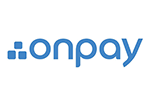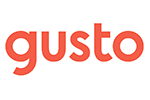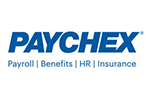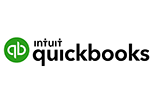Want to jump straight to the answer? The best online payroll service for most people is OnPay.
Employee payroll processing and the accompanying tax obligations are two necessary tasks that cause angst for even the most seasoned business owner or HR manager. And with good reason. Each year, about one-third of small businesses are fined by the IRS because of payroll mistakes.
Beyond stinging tax penalties, messing up your payroll even once results in unhappy workers. Mess it up twice? Your business reputation is on the line.
Automating payroll with an online payroll service is the best way to manage these risks.
I took a deep dive into the most popular options available today. From them, I picked the five most functional, intuitive, and reliable online payroll services for small- to medium-sized businesses.
Any of my top picks can help a business better manage their payroll. But each excels for a specific type of business or user.
The 5 Best Online Payroll Services
- OnPay — The best for simplifying all things payroll
- Gusto — The best for dispersed workforces
- Paychex — The best for experienced payroll teams
- QuickBooks Payroll — The best for solopreneurs and small teams
- ADP Payroll — The best for never outgrowing your payroll provider
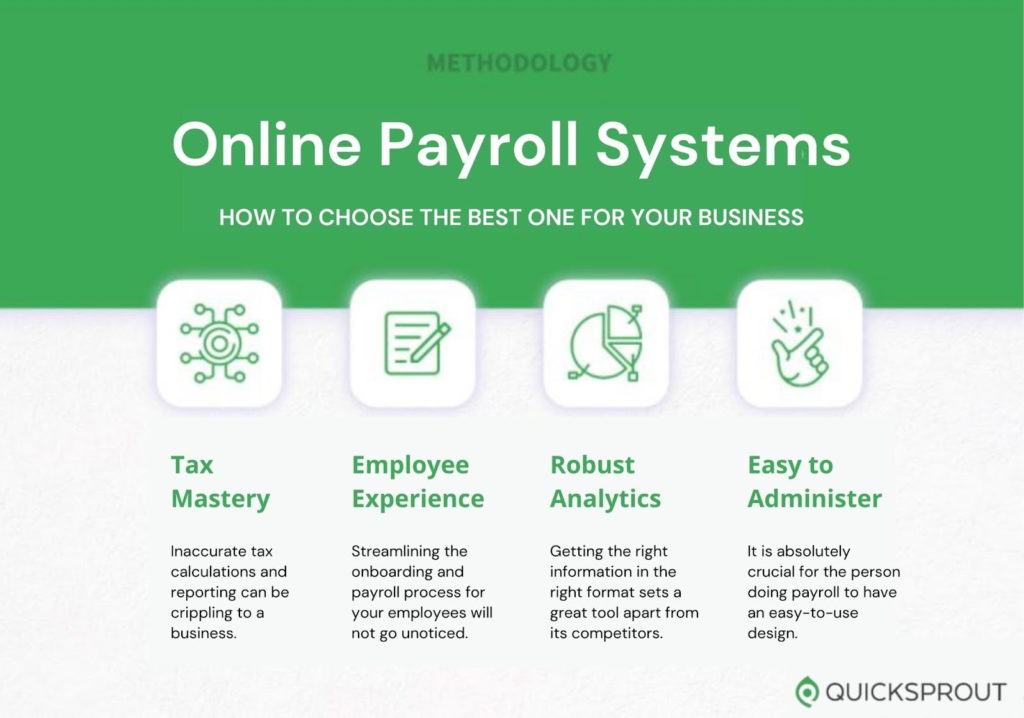
All five top picks are champs at managing common payroll tasks like scheduling, new hire reporting, and security.
Where they differentiate themselves—and what earned them a spot in my list—is how they perform in the key categories most users deem critical. These include ease of administration, employee use, reports, and tax management.
Read on to discover which solution is right for you.
#1 – OnPay — Best for Simplifying All Things Payroll
- Starting at $36 per month
- Unlimited monthly pay cycles
- Free multi-state filings
- Automated tax filings
OnPay began as an internal solution to help simplify one family’s payroll business. A decade later, OnPay is one of the most highly-regarded payroll services on the market.
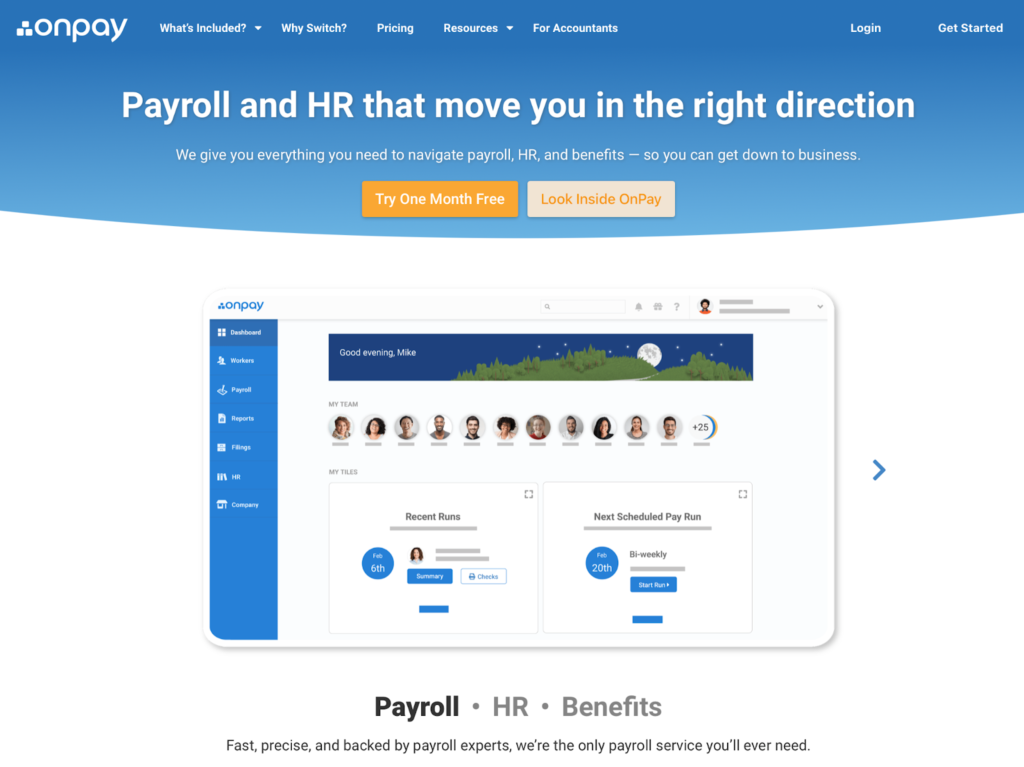
It’s this focus on simplifying the complexities of payroll that landed OnPay on my list.
No dedicated payroll or HR person at your company? No problem. OnPay successfully helps anyone master payroll management, regardless of experience.
Where OnPay Excels
OnPay delivers in a host of key areas that make it ideal for the inexperienced payroll user.
- Simplified payroll management: OnPay’s laser focus on making payroll as easy to understand as possible makes it a tool anyone can successfully use. You don’t have to be a seasoned HR professional to successfully run payroll each month.
- Easy employee onboarding and access: Most of the most common tasks like self-onboarding and reviewing payroll documents can be painlessly completed via OnPay’s website. This eases frustration for the employee and saves time for the employer.
- Stellar customer service: OnPay’s emphasis is on simplifying payroll for everyone, so it makes sense they put a strong focus on helping their customers. OnPay resolves issues quickly and effectively with no long hold times, unlike some of its competition on this list.
Users we spoke to, especially those with no formal payroll or HR experience, really liked how easy OnPay is to use.
“It’s easy for an individual who is not necessarily an accountant to operate this system,” noted one user we interviewed, “like where you have a business owner who’s going to be doing this stuff.”
OnPay also receives high marks on the employee use side. Reviews we studied consistently noted how easy the platform is for employees to access and navigate. They can self-onboard, print out paystubs, and change tax forms on their own.
This is a huge benefit to small companies that don’t have a dedicated HR team, since it eliminates a lot of the repetitive questions and tasks normally surrounding these activities.
OnPay comes with the basic HR tools any small biz needs, like automated onboarding workflows, customized PTO tracking, and new hire compliance reporting.
If you want or need more options, OnPay integrates smoothly with a select number of third-party apps for accounting, time management, 401(k), and compliance. It bears noting, though, that OnPay offers the fewest third-party integrations of any product on my top five list.
Still, if you’re using a tool in OnPay’s current integration repertoire, OnPay walks you through connecting the two with ease.
“We’ve chosen to integrate OnPay with a time management system called Deputy,” noted the business manager of a small health clinic. “It’s incredibly simple.”
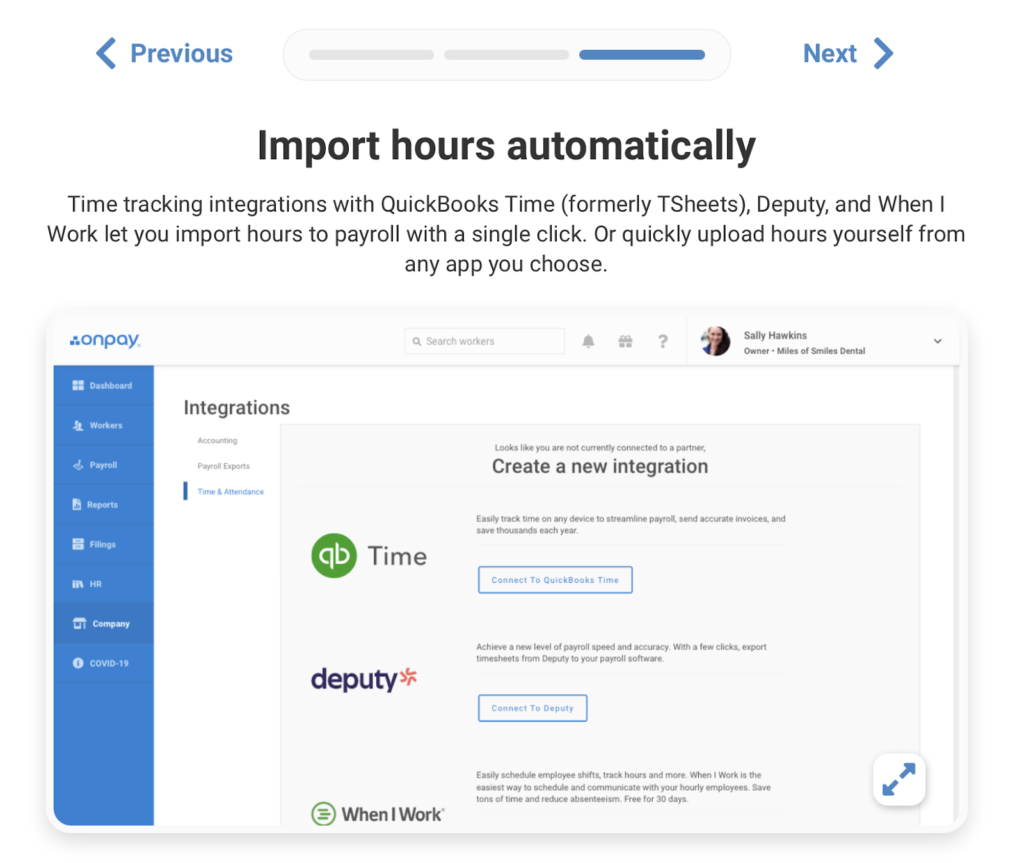
When questions arise, OnPay ensures fast answers.
“I think the longest I ever had to wait on hold was 10 minutes and they are always very helpful and polite,” the owner of a busy veterinary practice told us. “Their response every single time has been ‘we’ll take care of this for you,’ and they always do.”
And if a payroll tax mistake happens, OnPay doesn’t let its users go it alone. Another user we interviewed noted, “If I get a message saying there’s a [tax] miscalculation, I go straight to OnPay and they’re like, no worries, we’ll explain what we did, why we did it, and you shouldn’t have to worry about it.”
Another area where OnPay shines is reporting functionality, especially its pre-built reports. The people we interviewed and the user reviews we read online raved about how easy OnPay reports are to find and use, especially the year-end reports.
And when customized reports are what a user needs, OnPay simplifies the process with its Report Designer feature. A simple drag-and-drop user interface lets you add or remove up to 50 data points, move columns, adjust date ranges, set up filters, and create custom views for individual users.
OnPay’s customization extends to payroll cycles, too. Unlike others on my list, OnPay lets you run unlimited payroll cycles every month at no additional cost.
For small businesses, this is an especially important feature, as one user pointed out who forgot to add a new employee before running payroll.
“I forgot to click a button,” she recalled. After running the direct deposit payroll and seeing that she missed the new employee, she was able to go back in, quickly cut a check by hand, and ensure the new employee got paid on time. OnPay “is a great tool for me, because sometimes I forget to click a button.”
All in all, OnPay delivers where it matters most by taking the guesswork out of payroll.
| PROS | CONS |
|---|---|
| – Simplified payroll | – Doesn’t calculate local taxes |
| – Easy onboarding & employee access | – No mobile app |
| – Stellar customer service | – Limited integrations |
| – Straightforward reporting | – No automated payroll |
| – Unlimited monthly payroll runs | – Some difficult-to-master features |
Where OnPay Can Improve
No online payroll service is perfect, and OnPay is no exception. The software’s focus on making payroll as easy as possible also creates some gaps in functionality. Whether these gaps are a big deal depends on your needs.
- No automatic payroll option: While OnPay lets you run unlimited payroll cycles each month, there is no set-it-and-forget-it feature. You have to manually approve payroll every time, even if the data doesn’t change from cycle to cycle. All other top five products can do this.
- Some functionality is difficult to master: Despite its focus on simplicity, many users report unnecessary complexity in certain areas, particularly onboarding their more complicated processes at startup and extracting specific information from the system.
- Integrations are limited: Although OnPay integrates smoothly with the third-party tools listed on its website, those options are limited. There were less than 20 third-party tools at last count. All the other products on this list offer a far more robust portfolio of integrations.
One notable deficiency is the inability for a payroll administrator to set up payroll once and have it run automatically. You have to go in and manually work through two screens and a confirmation page each time you run a payroll cycle with OnPay.
This probably isn’t a huge hurdle for a small company with few employees or a payroll that fluctuates. But, for a company with a big workforce of salaried employees, this can quickly become an unnecessary burden. Other products on my list, like Gusto, Paychex, and ADP do offer this set-it-and-forget-it convenience.
While OnPay strives to be easy to use, there are some aspects where users struggle or face seemingly unnecessary annoyance.
One user we interviewed cited trying to find individual 401(k) information as an example. “I have to go into the 401(k) listing and then unclick everybody that I don’t want. I’d rather be able to just … click the person I want and run the report.”
Other OnPay users mentioned struggling with the onboarding process, at least for more complex situations. One person we interviewed noted that managing benefit accrual for different compensation schemes wasn’t easy to get set up. The same user also had trouble getting long-term employees on the correct benefit accrual schedule, noting that it required “a lot of back and forth” with OnPay to get things properly set up.
Then, there’s the lack of a mobile app for administrators or employees. OnPay claims its website allows users to run payroll from anywhere with “just one bar of reception.” Yet there is something more intuitive and easier about a well-designed app. Both Paychex and ADP have robust mobile apps. Even Gusto offers a limited mobile app for basic employee self-service.
A somewhat more niche issue arises for businesses that operate in places with municipal taxes. OnPay can’t handle local taxes, so if your business is subject to these, you’ll want a payroll service that can manage them for you. All the other choices on my list offer this service.
Finally, OnPay drops the ball a bit with fewer than 20 third-party app integrations. It lags far behind its competition in this regard. This also leaves a pretty wide gap for new OnPay users who already use accounting, time management, and 401(k) tools that aren’t on the list.
OnPay Pricing
OnPay really shines when it comes to pricing, for several reasons. Forget complicated tiers and customized quotes. OnPay offers all its services for one monthly fee, and it’s a fee that puts OnPay among the most affordable options on my list.
Their approach to pricing also garners rave reviews from actual users. “If you’re a small business like we are…it is an incredible value,” notes the business manager of the small health care clinic.
OnPay costs just $36 per month plus $4 per person per month. That’s it. No contracts. No mysterious fees. No uncertainty.
There’s even a simple calculator on their website that lets you see exactly how much you’ll pay, without ever having to talk to a single OnPay sales person.
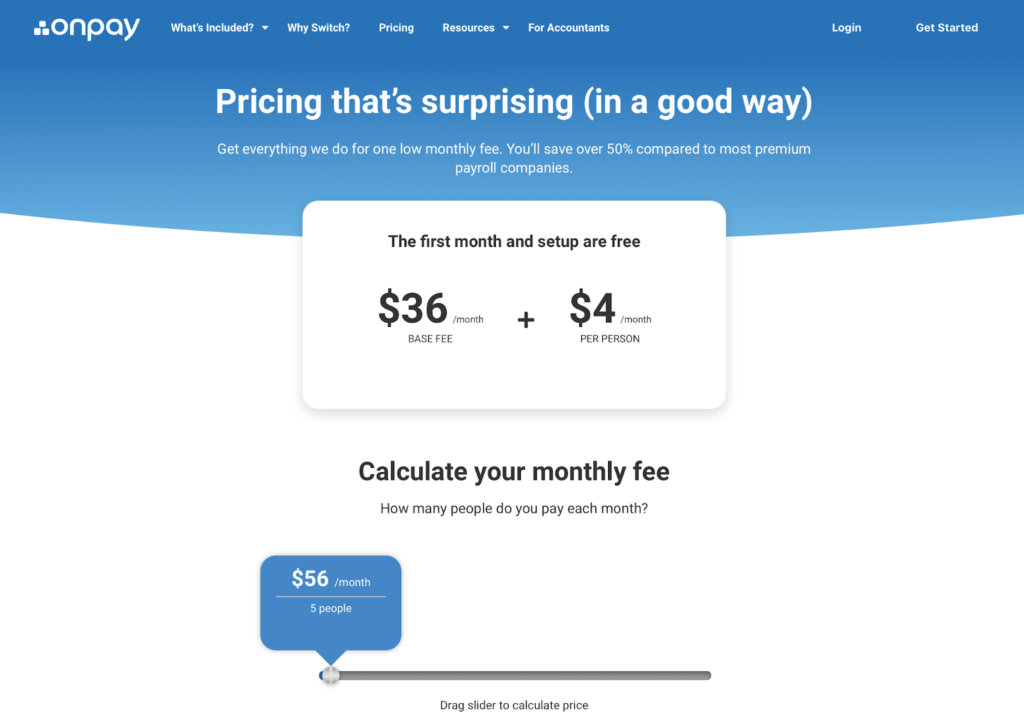
Other key features of OnPay’s pricing:
- 30-day free trial
- Migration costs from your previous payroll provider are covered
- No contract, cancel anytime
Bottom line: Small business owners and managers without payroll expertise will love the simple interface, solid customer service, and budget-friendly pricing of OnPay.
#2 – Gusto — Best for Dispersed Workforces
- Starting at $39.99 per month
- Best for startups and new businesses
- Unlimited payroll cycles
- Easy access to pay stubs & benefits
Gusto started life as ZenPayroll back in 2012. As client demands evolved, Gusto evolved beyond basic payroll services to offer a comprehensive suite of features that makes it easy to onboard and manage employees anywhere.
Today, Gusto processes tens of billions of dollars of payroll for 100,000 businesses throughout the United States. Some have localized workforces while others are fully remote, with employees spread out across all fifty states.
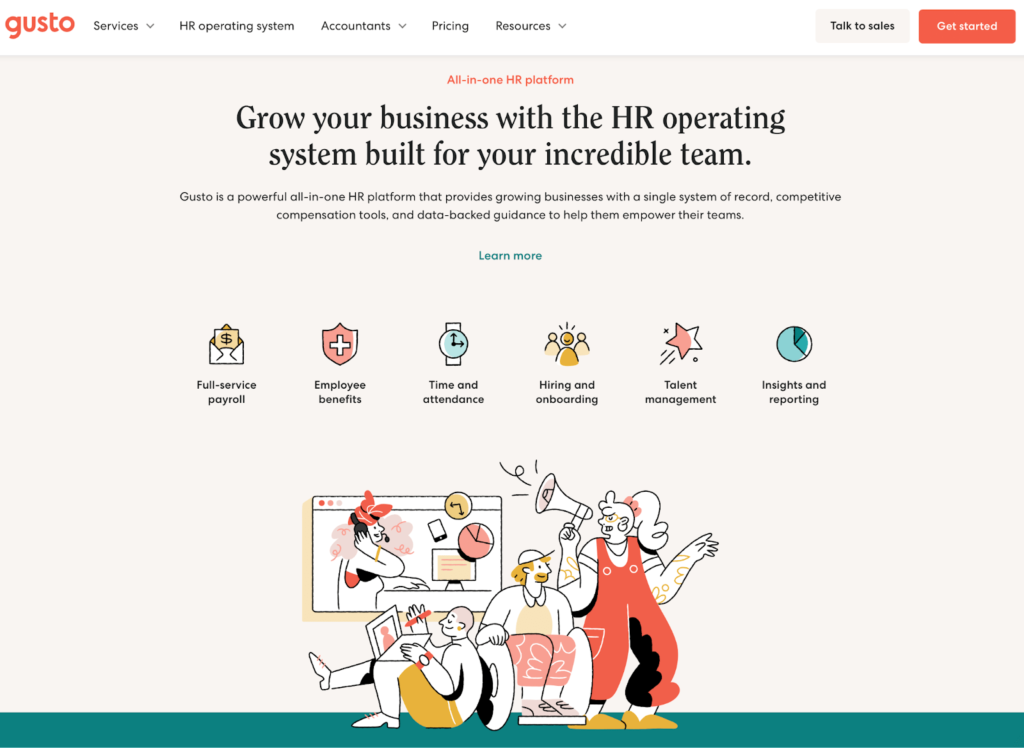
Gusto makes managing dispersed workforces easy with a friendly and engaging user interface that simplifies payroll, HR, and benefits for administrators and employees alike.
Where Gusto Excels
Much like OnPay, Gusto focuses on the user experience, turning a complicated topic into something easy to use and manage. They also make it fun along the way, with a lighthearted approach to design.
Where Gusto separates itself from OnPay, though, is in how they approach this while simultaneously including the core functionality that a bigger business demands. This unique combination of ease of use and robust functionality is why I included Gusto on my top five list and why it’s best for predominantly remote teams.
Here are the areas where Gusto stands out the most:
- Easy for everyone to use: When you’re managing a remote workforce, onboarding and interacting with new employees is a challenge. Gusto not only makes it easy for a new business to get up and running, but it is equally easy for new employees to get up to speed, too.
- Robust hiring and onboarding tools: If your business is growing, streamlining these processes is critical. Gusto lets you get new employees up and running in a completely hands-off way. This makes Gusto especially great for hiring remote employees.
- Built-in time management tool (in higher tiers): If your workforce needs to track its time, you can subscribe to a higher tier of Gusto service and have this feature included. This means you can skip the integration with a third-party tool, unlike OnPay, which only offers integrations and no native time tracking functionality of its own.
Users rave about Gusto’s clean and easy-to-navigate design. While the prancing, animated pigs and cartoon illustrations aren’t everyone’s cup of tea, they do resonate with Gusto fans. As one user we interviewed exclaimed, “Thank God we have Gusto. Look how easy this is. Yay!”
Onboarding new staff is also a breeze, with simple checklists, templates for essentials like offer letters, and the ability for digital signatures. Gusto makes it so easy for employers that in-person onboarding is quickly becoming a thing of the past, even for localized workforces.
Explaining how her company’s new employee onboarding process changed with Gusto, Liz, the HR manager for multiple $1 million companies, said her team made an explainer video of how the employee’s new tablet works. Instead of a lengthy sit-down with a new hire going through the tablet’s functionality, her team simply shares that video via Gusto.
Likewise, new employees can onboard with ease, which is critical for remote workers. You can send an automated email series that walks the employee through all the tasks needed during the onboarding process. It lets employees work with manageable chunks of information, rather than experience data overload on their first day at work.
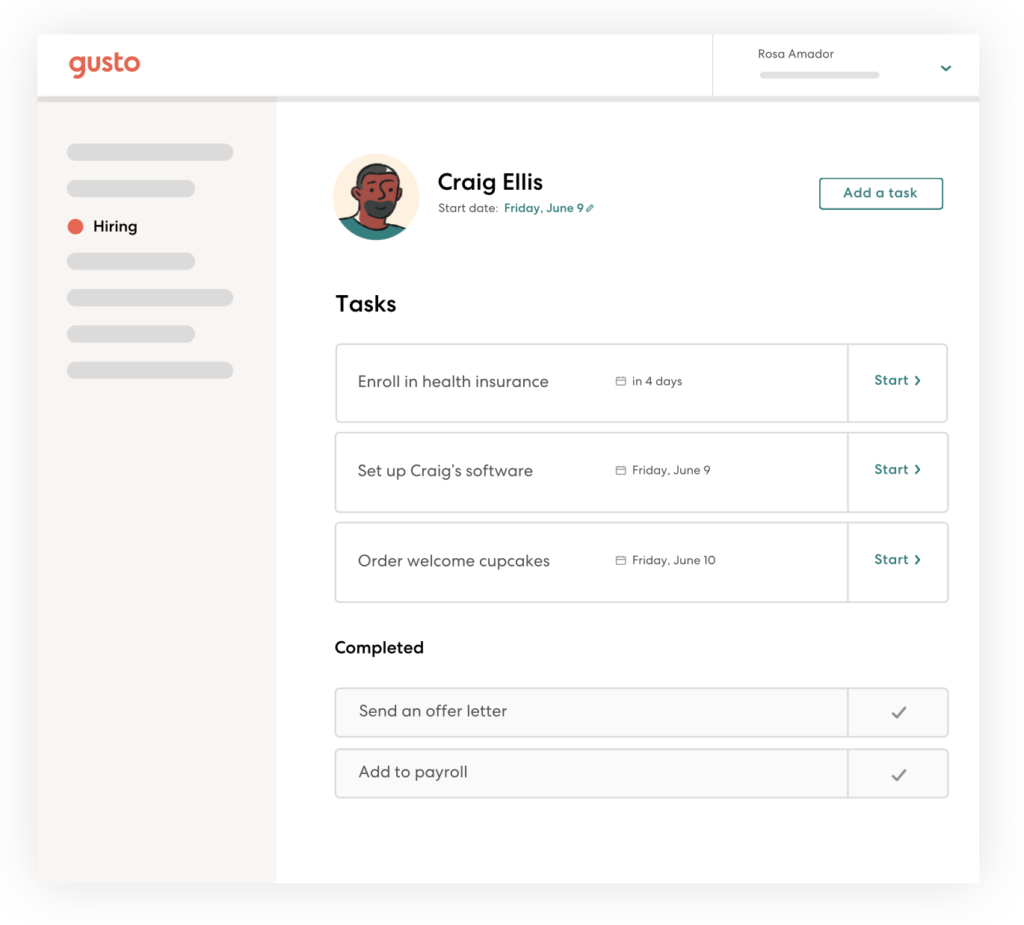
As Liz also found out, Gusto makes it understandable for even the least tech-savvy person on staff, saving her team time and energy addressing common user issues.
“The same group of people that are using Gusto are also using other platforms we use,” she said. “I hear all of this stuff around all of these other platforms, but I don’t around Gusto.”
Gusto also gives you flexibility when it comes to running payroll each month, offering unlimited payroll runs. Just like OnPay, you’re not locked into predetermined payroll cycles, nor charged extra if your payroll processing needs increase. With Gusto, you can adjust as your needs change or when you need to address a one-off situation.
Unlike OnPay, though, Gusto gives you the convenience of automated payroll. This is an especially great feature for businesses with static payrolls, like an all-salaried team.
Once you set up the initial payroll information, you can set it to run automatically every pay cycle. Need to change something? A simple toggle switch lets you turn this feature on and off as required.
Finally, if your business is subject to local taxes, Gusto makes it easy to manage and submit these withholdings. This is another area where Gusto pulls ahead of OnPay, which doesn’t offer this feature.
Combined, all of Gusto’s pros make it an ideal tool for growing businesses with dispersed workforces.
| PROS | CONS |
|---|---|
| – Easy for everyone to use | – Poor customer service |
| – Manages local taxes | – Benefits not available in all 50 states |
| – Unlimited & automated payroll | – Difficult integrations |
| – Robust hiring/onboarding tools | – Basic plan lacks PTO requests |
| – Built-in time tracking on some plans | – No mobile app |
Where Gusto Could Improve
Of course, despite all the ways Gusto wins over users, it does have some shortcomings that bear calling out.
- Customer service leaves much to be desired: When it comes to keeping customers satisfied, Gusto stumbles. While they might answer your initial call quickly, users consistently said it takes multiple calls over days and weeks to actually resolve the issue.
- Integrations are difficult: Although Gusto says it “plays nice with your favorite software” and lists more than 100 third-party tools, user experience tells a different story. In particular, users experienced issues trying to integrate Gusto with popular accounting packages like Xero, FreshBooks, and Sage.
- No PTO requests or approved-PTO syncing (on basic plan): To get the same PTO functionality of OnPay, Gusto users will need to subscribe to a higher-tier, more expensive plan.
Users we interviewed were united in their criticism of Gusto customer service. Although customer service representatives are available Monday through Friday with extended business hours, the reps seem ill-equipped to handle user questions.
Likewise, many users complained of long wait times and needing to make multiple calls over many days and weeks to ultimately resolve questions.
“They ran me around in circles actually,” noted one former Gusto user. “I think it’s because they didn’t know…didn’t understand their own services.” He eventually left Gusto because he wanted a more cut-and-dried approach to payroll management.
When you are a new startup without a dedicated HR department and want more hand holding, this might be an issue. It’s also one area where OnPay and some of the other top five offerings trump Gusto.
Limited benefits is another area where Gusto stumbles a bit. While they have built a robust, one-stop-shop for payroll and HR services, that comes at a cost. According to many users we interviewed, Gusto wants you to forego your existing service providers in favor of Gusto or one of its preferred brokers.
“I wanted to get set up with HSA benefits…and they gave me a big runaround about that,” said one former Gusto user. “They told me that they would take care of …the health insurance part of my payroll. What they actually were offering …was to be a healthcare reseller…the broker for the group plan for my company. Which is not at all what I wanted. I wanted them to do the payroll aspect. Not be a group manager for my healthcare.”
Likewise, Gusto’s HSA and FSA benefits are not yet available nationwide. While payroll and 401(k) are available everywhere in the United States, HSAs and FSAs are only available in 38 states plus DC. If your business or employees happen to be in one of the 12 states not yet covered, this will present a challenge—at least if you want Gusto’s services in this regard.
Just like OnPay, Gusto relies on an optimized website instead of a dedicated app for mobile use. It isn’t a deal-breaker, but I am curious why a product with such a focus on the user experience skimped on this feature.
Gusto does offer a limited employee-facing app called Gusto Wallet. This lets employees see pay information and tax documents, but that’s about it. Everything else must be done in the web version of Gusto.
Most surprising on this list is Gusto’s difficulty integrating with common third-party tools, in particular accounting software. One of our interviewees struggled to connect Gusto with Xero, eventually giving up and leaving Gusto for another service. “They said it would sync, but they did not play at all nice together,” he noted.
Gusto Pricing
Gusto takes a more traditional approach to pricing, similar to ADP, Paychex, and QuickBooks Payroll. It offers multiple tiers of service, in stark contrast to the single-price approach of OnPay.
Gusto offers three tiers: Core, Complete, and Concierge. With each, you pay a flat monthly fee plus a per employee rate. There is also a Select option which offers full customization, including the price.
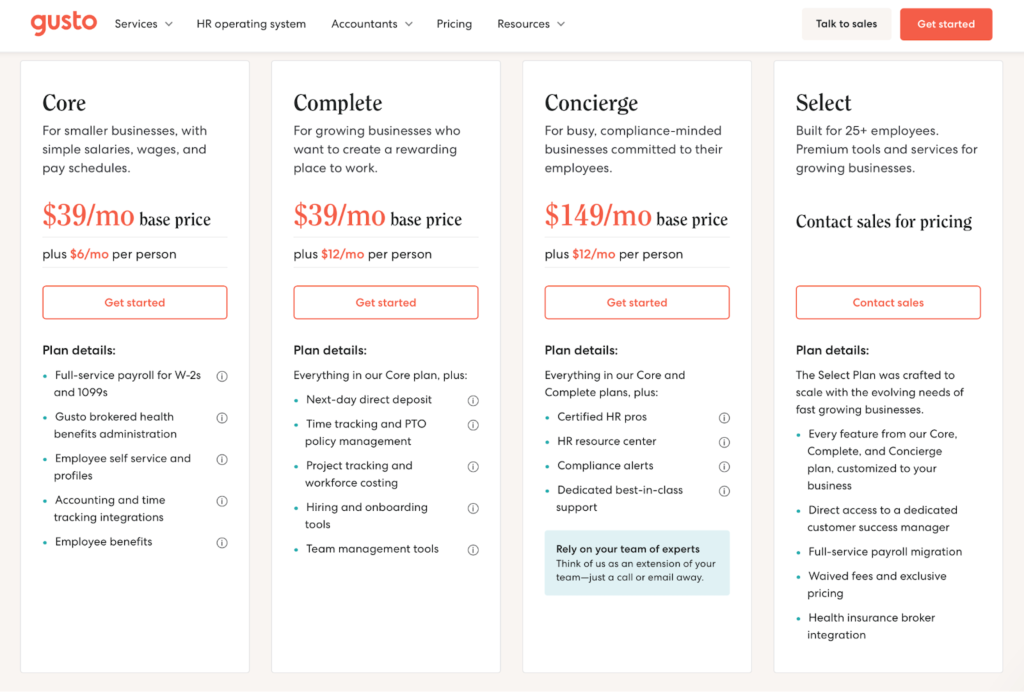
- Core – $39/month plus $6 per employee per month. Core includes employee self-service, health benefits and worker’s compensation administration, and PTO policies. Unlike OnPay, no PTO or time tracking are included in this basic tier.
- Complete – $39 per month plus $12 per employee. This tier offers all the Core features, plus employee offers and onboarding, time tracking, time off requests, and an employee directory and surveys.
- Concierge – $149/month plus $12 per employee per month. Includes all Core and Concierge features, plus access to certified HR professionals and an HR resource center.
Whichever package you choose, Gusto also lets you add a la carte services for an additional fee:
- 401(k) plans
- 529 college savings plans
- HSAs & FSAs (not in all states)
- Workers compensation
Uniquely, Gusto also offers a contractor-only option for companies that don’t have any W-2 employees. It costs $6 per person with no monthly base price, and includes limited services, including:
- Unlimited contractor payments in all 50 states
- 4-day direct deposit
- 1099-NECs
- New hire reporting, as required
Gusto offers a free 30-day trial, so you can see what it’s all about without any financial commitment.
Bottom line: Progressive business owners and HR professionals managing a workforce spread across diverse locations will love Gusto.
#3 – Paychex — Best for Experienced Payroll Teams
- Starts at $59 per month
- Tailored for big businesses
- 24/7 live support
- Excellent mobile app
Paychex is one of the two heavyweights in my top five list. The service has been around seemingly forever, and generations of workers have seen the Paychex logo on their payroll stubs.
In its 50-year history, Paychex has grown to offer a full suite of payroll, HR, time tracking, and benefits services.
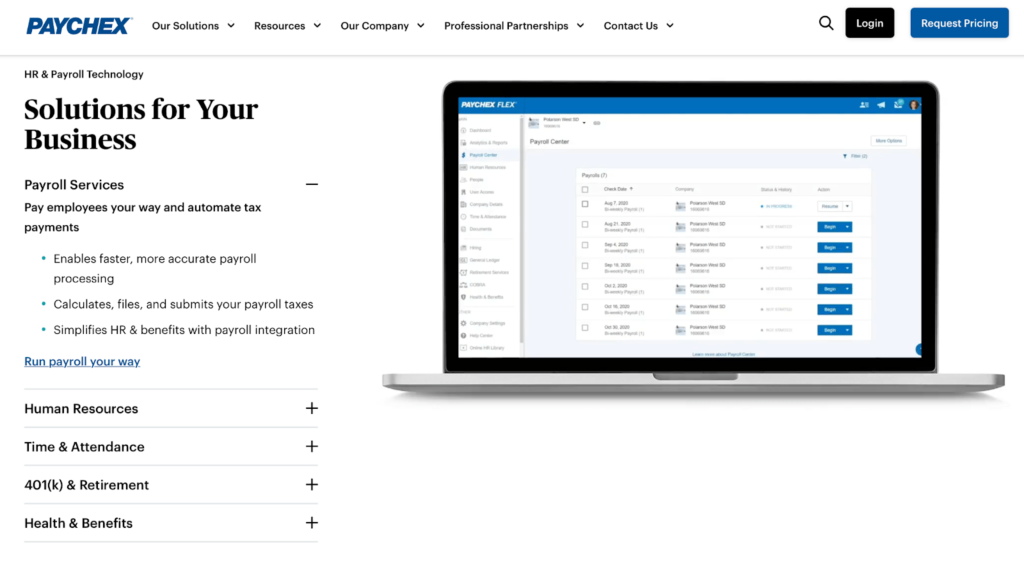
This robust service offering speaks to the market Paychex best serves. While they will gladly onboard small companies with fewer than ten employees, their real sweet spot is larger businesses with lots of employees and a dedicated HR staff.
In other words, unlike OnPay and Gusto, the Paychex focus is less on aesthetics and hand-holding for the inexperienced user, and more on offering services geared toward companies with complex payroll and HR demands.
Where Paychex Excels
- Advanced customer service: A company this size can offer 24/7 customer service, and Paychex delivers. At the higher subscription tiers, they also provide a dedicated payroll specialist for each customer. This specialist functions as the point of contact for all customer inquiries.
- Excellent payroll tax law knowledge: With the resources at Paychex’s disposal, you’d expect them to confidently manage tax laws at all levels, including local. And they do. The same can’t be said for Paychex heavyweight counterpart on this list, ADP.
- Integrated time tracking services: Paychex focuses on making it easy to track employee time, no matter which tier of service you buy. Their Time Clock feature works like a traditional punch in/punch out system. They also offer Paychex Flex Time, a more robust cloud-based time and attendance solution. Both time management options seamlessly transmit data to payroll and HR systems.
I was surprised at just how excited the users we spoke to were about Paychex’s customer service. In particular, they noted that issues get resolved quickly. This extends to all levels of customer service, not just the dedicated payroll specialist. So even companies that don’t choose a tier that provides an assigned specialist to them still receive great service.
As one Paychex user who manages a 35-person company noted, “Usually I will call if it’s like a payroll issue, and if my payroll specialist isn’t available, you go to anybody in the pool and 99%—I mean, probably even 100%—of the time, the person I speak to is extremely knowledgeable and will resolve it for me without having to go to my specific payroll specialist.”
When it comes to correctly processing taxes, Paychex also receives high marks. This isn’t surprising, since Paychex has been at this for a very long time, and has the resources to make sure nuanced tax changes are addressed, even down to the local level.
“Massachusetts recently installed a state-funded paid family and medical leave act,” the owner of a 100-person firm told us. “So that ended up being a new payroll tax and Paychex handled that without issue.”
And when there is a hiccup, users were also quick to point out that Paychex owned the mistake and resolved it quickly on the customer’s behalf. One interviewee noted that Paychex also credited them several months worth of fees to make up for the inconvenience.
Paychex also puts a focus on the mobile aspect of payroll in two ways. First, unlike OnPay or Gusto, Paychex does offer a mobile app for administrators. This allows admins to process payroll from anywhere at any time without having to use a web browser on their mobile device.
Second, Paychex offers several time tracking options that work for localized and mobile workforces.
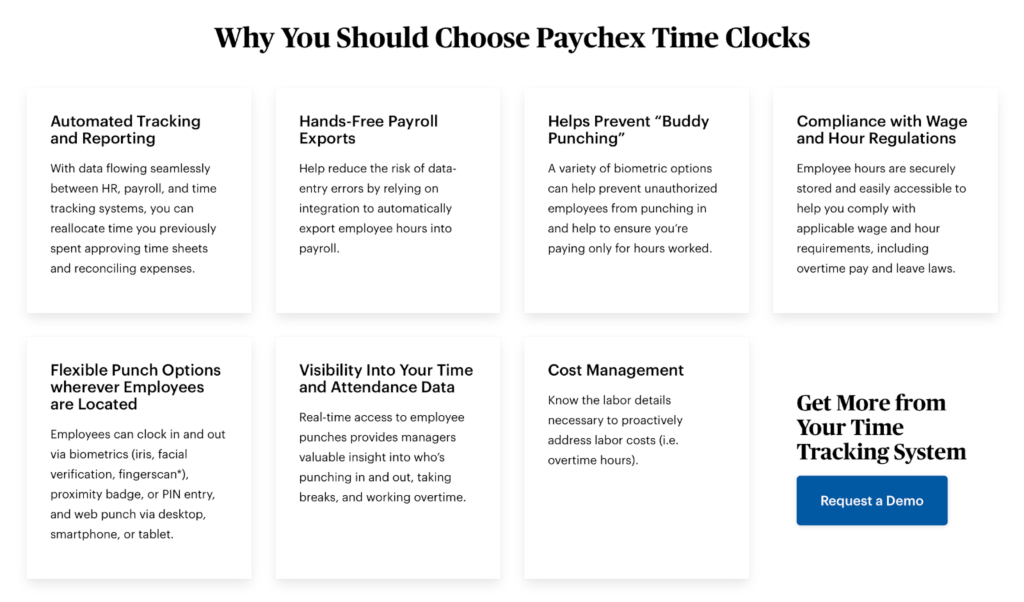
“One of the big reasons for moving to Paychex was to take advantage of the online Time Clock,” said one Paychex user. “Having an automated system for checking in and checking out is super useful. This is a much more streamlined system. It definitely saves time.”
Reporting is a key component of any payroll service, and Paychex users had many good things to say about it. In particular, users loved the built-in Payroll Journal and Employee Earnings Report.
Even when it came to custom reporting, users noted that the drag-and-drop feature made pulling customized information fairly straightforward. This is a standout among customized reporting across all products in my list.
Paychex definitely understands the sophisticated needs of its target audience, and does a great job of satisfying them.
| PROS | CONS |
|---|---|
| – Effective customer support | – Complicated user interface |
| – Excellent tax knowledge | – Confusing onboarding process |
| – Built-in time tracking | – Difficult to integrate |
| – East custom reporting | – No transparency of pricing |
| – Mobile app | – Aggressive salespeople |
Where Paychex Could Improve
Although Paychex does a great job overall, there are still a few areas that could be improved to eliminate some recurring complaints.
- User interface is complicated: While the design is far more bare bones than OnPay or Gusto, Paychex makes it complicated with too many choices. This again speaks to their target audience not being the hand-holding type but instead seasoned HR teams. While an experienced HR professional probably won’t have trouble diving into Paychex, users with less experience often find it a challenge.
- Lots of integrations but difficult to integrate: With more than 100 available third-party integrations, Paychex seems to work with almost any other tool you might already use. However, many users note that actually getting the two to play nice together is harder than expected.
- Pricing is a huge secret: Paychex is very guarded when it comes to disclosing pricing. Unlike any of the other services on this list, Paychex makes you jump through a lot of hoops to find pricing or packages, if you ever do. Instead, they want you to sign up for a free consultation to get a custom quote.
When it comes to learning a new payroll software, there are two types of people: those who know a lot about the subject and want to dig in on their own, and those who are new to payroll and want more personalized attention.
Paychex is definitely a service for the former, as one interviewee told us when discussing the onboarding of new employees.
“My issue is just that I haven’t been handed anything that says ‘here’s how it should all work from beginning to end.’ I’m trying to figure that out all on my own,” she said. “It would be nice to have it all provided to me.”
Likewise, although the administrator user interface is pretty bare bones, it still causes confusion for some. Experienced HR teams will no doubt jump in and enjoy the ride, but someone without much payroll or HR knowledge might feel intimidated and overwhelmed by the options. It is not impossible, but will take a few payroll cycles to make it all feel natural.
One area that surprised me was user complaints about how difficult some integrations are, especially when it comes to time tracking software. In some cases, the difficult integration results in additional work for a Paychex customer.
As one user illustrated, “Paychex has their own time-in reporting product. We don’t use that…because we already had one that was DCA approved because we’re a federal contractor. Paychex is probably DCA approved, but why bother? Why recreate the wheel? So we have a separate system and I have to put the PTO in manually to Paychex.”
And finally, Paychex is extremely mysterious when it comes to sharing price information online. Whether this is because they are expensive or they just want to make you engage with their pushy sales team or both, it is something several people we interviewed noted as a problem.
“That’s probably one of my largest complaints working with Paychex,” one current Paychex user told us. “They do promote a low upfront cost because they factor in a number of discounts, but then those discounts over time just disappear.”
Likewise, the Paychex sales team didn’t escape scrutiny. Paychex sales people are just plain pushy. Dozens of reviews ripped Paychex for their aggressive sales pursuits including repeated emails, phone calls, and texts to existing customers. Their sales tactics, even for existing customers, leaves something to be desired.
“The only issue I’ve had is their sales people,” noted another Paychex user we interviewed. No other product on this list gets these kinds of complaints.
Paychex Pricing
Finding Paychex pricing information on their website is like searching for the holy grail. It might be out there somewhere, but it’s really hard to find. And when you eventually do find it, you feel like you accomplished something extraordinary.
This is a totally different approach than Gusto, OnPay, and QuickBooks, who all put their pricing front and center.
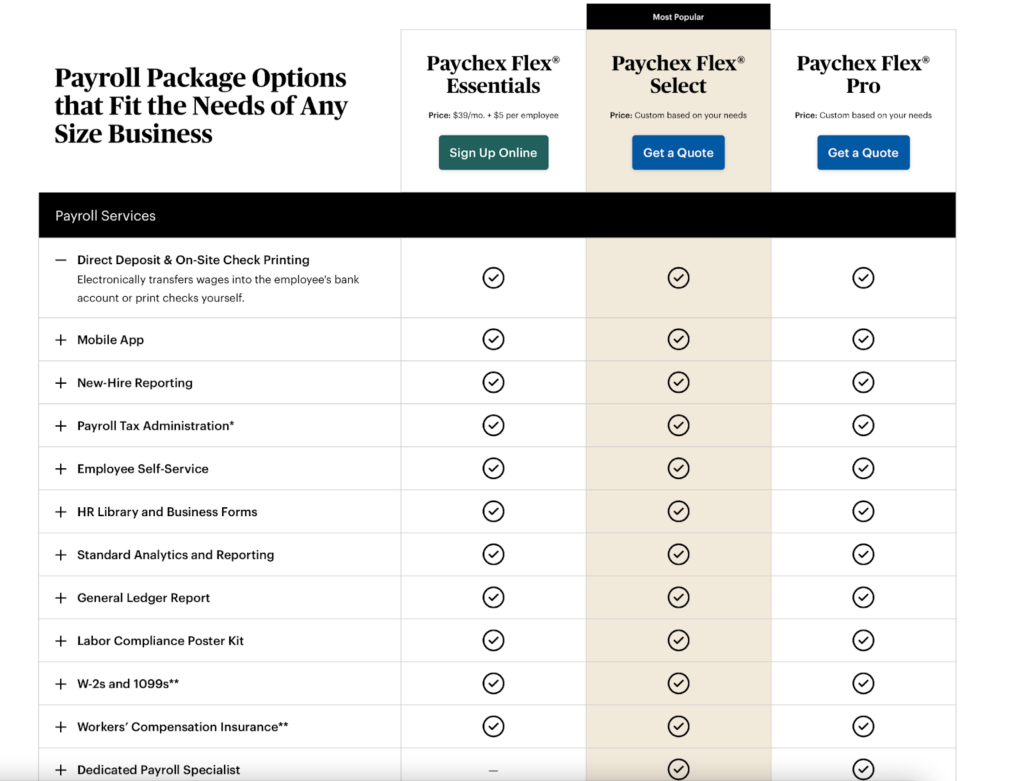
- Flex Essentials – $39 per month + $5 per employee. Covers the basics. Offers fewer services for more cost than either Gusto or OnPay.
- Flex Select – custom quote only. All the services of Flex Essentials, plus a dedicated payroll specialist, mobile app for payroll administrators, access to e-learning services, and more employee pay options.
- Flex Pro – custom quote only. Everything from Essentials and Select, plus services typically only needed by larger businesses. Also, you have to jump to this tier to get basic services like accounting integrations and garnishments, services offered by others in the top five at lower price points.
- There’s no 30-day free trial, but Paychex does occasionally run specials that offer three months free. However, you’ll have to search to find those.
The danger with Paychex pricing, confirmed by numerous user reviews, is that costs can go up fast, especially as a la carte services are added. Some people leave the service over price increases.
Bottom line: For the experienced payroll team or HR professional, Paychex is an incredibly powerful tool…but all that power will be a bit much for users without a payroll background.
#4 – QuickBooks Payroll — Best for Solopreneurs and Small Teams
- Starting at $45 per month
- $25,000 tax penalty protection
- Full-service payroll
- Great for managing invoices
The power of a brand can never be understated, and QuickBooks is an instantly recognizable name in accounting software.
The company has spent decades earning its reputation as being reliable and easy to use. This reputation extends to QuickBooks Payroll.
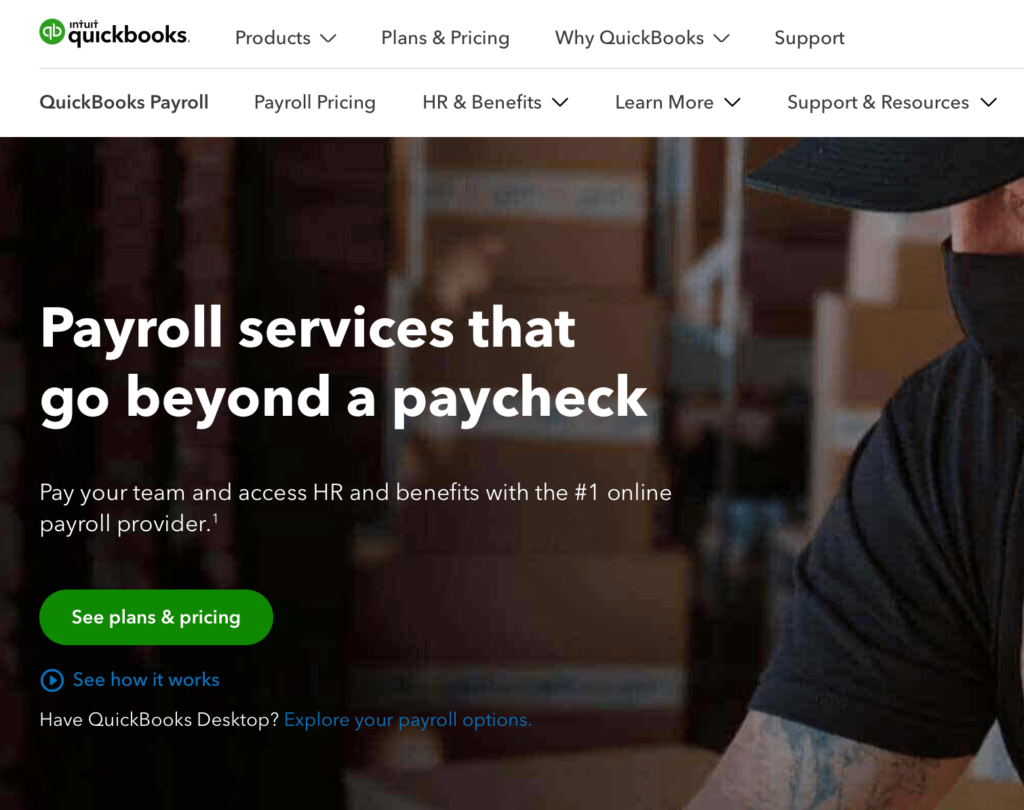
It’s a no-brainer to tell you that QuickBooks Payroll is perfect for anyone already using QuickBooks for their accounting. You can even integrate the two from within QuickBooks accounting software with just a click.
But QuickBooks Payroll is also perfect for any small business that wants a standalone, trimmed-down product for payroll management—something that’s easy to use and gets the job done without unnecessary bells and whistles.
QuickBooks delivers a compact package of payroll services at a reasonable price, best suited for individuals and small companies that prioritize cost over extra functionality that they don’t need.
Where QuickBooks Payroll Excels
QuickBooks Payroll offers a number of great features that are perfect for the solopreneur or business owner tasked with managing small teams.
- Very intuitive: QuickBooks Payroll nails it when it comes to making it easy for people with little to no payroll background to get people paid. Its new Payroll Tax Center dashboard makes the entire service easier to use.
- Tax penalty protection: Uniquely among products on my list, QuickBooks Payroll offers actual monetary protection (up to $25,000 per year) to cover tax penalties and interest. While you have to be on the highest tier of service for this coverage, this type of insurance can save a small business from financial ruin.
- Simplified time tracking: QuickBooks Time allows users to track time on the go via the website or a dedicated mobile app, then feed the data back into QuickBooks Payroll automatically.
The users we interviewed all used QuickBooks Payroll in conjunction with QuickBooks. They unanimously agreed that QuickBooks Payroll saved them significant time every month. It also trimmed down expenses.
One user noted that before turning to QuickBooks Payroll, they were spending at least an hour each month running payroll. Since converting, though, their processing time has been reduced to just minutes.
And, as another interviewee noted, “It’s saving me money from having to pay my accountant/bookkeeper.”
For users willing to pay a bit more each month, QuickBooks Payroll’s tax penalty protection can be a real lifesaver. When you are on the IRS’s radar, things can get sticky fast. Knowing your payroll software has your back can be worth the extra cost of the higher tier package.
The reviews we read and the users we talked to consistently heaped praise on the prebuilt reports, as well. While 20 ready-to-go reports may not seem like a lot, for users with simpler needs, it is a nice compromise between covering the basics and overwhelming a user with too many choices.
Time tracking is a huge win, too. The QuickBooks Time mobile app for Android and iOS lets you accurately track hours no matter where or when an employee is on the clock. There’s even geofencing technology baked into the app, something unique among our top five products.
Users also find QuickBooks Time easy to manage and quite versatile, with one user even adopting it as an internal way to manage billable hours for clients.
“We use QuickBooks Time in a way that wasn’t designed for, but…works for us,” noted one user we talked with. “We’re a marketing agency, so we have our different customers and…we track the time we’re spending on any given account and any given day. It’s for internal tracking, just so we’re not over servicing or under servicing a client.”
QuickBooks Time is available as an a la carte service at the lowest QuickBooks Payroll subscription tier, and included at the higher tiers.
| PROS | CONS |
|---|---|
| – Solid built-in reporting | – Limited integrations |
| – Simplified time tracking | – Poor selection of HR tools |
| – Saves time & money | – Lackluster customer service |
| – Affordable pricing | – Manual state tax management |
| – Tax penalty protection on Elite plan | – Unexpected service issues |
Where QuickBooks Payroll Could Improve
QuickBooks Payroll is great for many things, but not everything.
- Limited integrations: If you’re not using QuickBooks Online for accounting, the third-party tools you can integrate QuickBooks Payroll with are extremely limited. In fact, you can only integrate with other Intuit products.
- Customer service leaves much to be desired: Slow to respond, slow to follow up, and difficult to contact were just a few of the comments we read and heard about QuickBooks customer service.
- Few HR tools: QuickBooks Payroll lags here, especially when compared to what the other top five offer. For users who want both payroll and HR this is an issue.
The biggest issue for QuickBooks Payroll is how limiting it is for anyone not already using, or willing to adopt, QuickBooks for accounting purposes. Without it, users can’t make use of the 650+ third-party integrations QuickBooks Payroll boasts about.
Users also cannot integrate QuickBooks Payroll with any other accounting software. That’s a huge limitation for anyone wanting to do more than the basics of payroll.
Also, of all the products on our top five list, QuickBooks Payroll really drops the ball with customer service. Dozens and dozens of reviews consistently mention bad customer service—in particular, long hold times.
“If you have a problem with QuickBooks and you try to call them, you’re going to be on the line forever trying to get help,” noted one person we interviewed.
Likewise, when unexpected problems arise users often have to turn to third-party resources for more information. One interviewee experienced this first-hand.
“The direct deposit payment was supposed to hit on the 30th, and nobody got it,” he noted. “I sent it and then found out through the [QuickBook] forums that it was a QuickBooks issue.”
Many users report significant issues with employees not getting paid or tax-related issues with the IRS. These complaints stretch back all the way to 2016. Combined with limited customer service, these unexpected hiccups can be very frustrating for an inexperienced payroll manager.
Limited HR tools are another sore spot. There’s no easy or fun onboarding experience like Gusto and OnPay offer. You also don’t get the higher-level employee benefits of ADP and Paychex.
You can only start capturing a small portion of these services with QuickBooks Payroll’s highest-tier plan, which is far more expensive than OnPay or Gusto.
Tax calculations are also a potentially problematic area for some businesses. QuickBooks Payroll requires manual entries for workers who perform services in multiple states.
The same holds true for employees that move often. QuickBooks Payroll will only track a maximum of two states. So if you have a multi-state workforce, you might find QuickBooks Payroll a bit limiting.
This is likely not an issue for most solopreneurs or very small companies. But it is an example of how QuickBooks Payroll is not ideal for larger companies with many employees.
QuickBooks Payroll Pricing
QuickBooks Payroll offers some of the least expensive pricing on our list, including 50% off for the first three months. Only OnPay costs less after the three-month discount is removed. This affordability makes QuickBooks Payroll a solid choice for an individual or small business that really just wants to manage a small payroll, and doesn’t want to pay for unnecessary extra features.
In line with targeting individuals and small businesses, QuickBooks Payroll offers crystal-clear pricing on its website. This makes it easy for anyone to understand options and start service with just a few clicks.
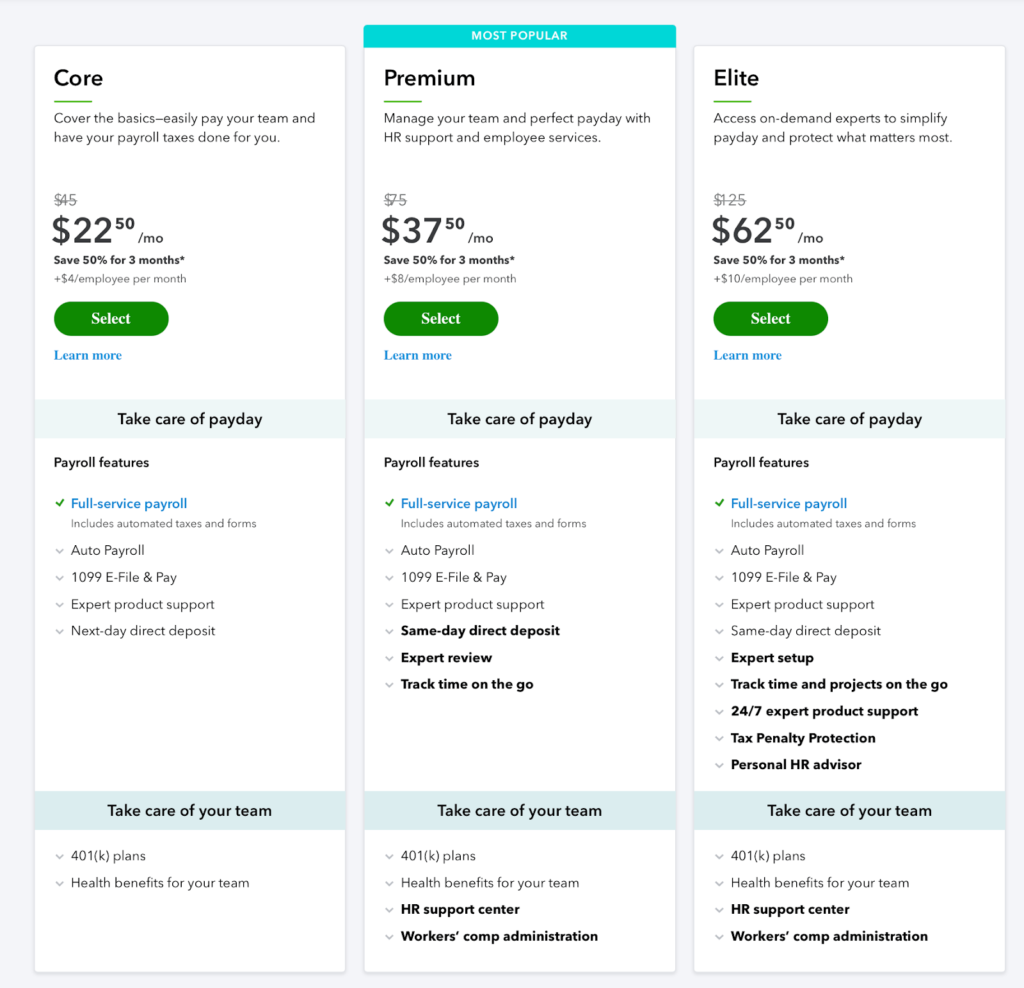
- Core – $45/mo plus $4/employee. This is the entry-level plan and offers auto payroll, 1099 e-file and pay, product support, and next-day direct deposit.
- Premium – $75/mo plus $8/employee. All Core offerings, plus same-day direct deposit, expert payroll review, mobile time tracking
- Elite – $125/mo plus $10/employee. All Core and Premium offerings, plus expert setup, mobile time tracking, 24/7 support, tax penalty protection, HR advisory services
QuickBooks Payroll also offers a la carte services, including:
- 401(k) plans
- Health benefits
- Time tracking app
- Worker’s compensation administration (higher tiers only)
- HR support center (higher tiers only)
QuickBooks Payroll offers a 30-day free trial, plus special introductory pricing of 50% off for the first three months.
Bottom line: If you’re a solopreneur or small business owner with less than 10 employees who just wants straightforward payroll services, QuickBooks Payroll is a solid option.
#5 – ADP Payroll — Best for Never Outgrowing Your Payroll Provider
- Marketplace offers tons of benefits
- Pricing plans great for scaling
- Robust HR features
- 25,000+ job boards
ADP is the most dominant name in the payroll industry, and has had more than 70 years to perfect its game. It offers a comprehensive suite of payroll, HR, and human capital management services under one umbrella.
ADP is by far the most feature-rich product in my top five list, providing every conceivable payroll-related service a business could need. If there’s anything you want to track or do related to payroll or HR in your company, ADP likely offers it.
And that’s exactly why ADP hits the sweet spot for companies with significant workforce expansion dreams. Your business will never outgrow ADP.
Where ADP Payroll Excels
When you’re a behemoth in the payroll services space, you achieve that by delivering some big wins over and over. Here’s where ADP excels:
- Flexible payroll processing: ADP makes it easy to segment and run payroll for groups of any size, set custom payment dates, and manipulate custom fields without limitation. ADP is the reigning leader in this regard among all five on my list.
- Mobile apps galore: ADP offers apps for both iOS and Android on both the admin and employee sides. Admins can easily manage payroll and HR anyplace and anytime on any device. Employees can get the individual information they need on demand, too.
- Integrations are virtually limitless: ADP lists hundreds of third-party tools it integrates with, ranging from basic accounting software to complex enterprise resource planning tools. Head and shoulders above all the competition.
ADP is a tool built to support your business at every stage of growth. One area where this is clear is the flexibility built into payroll automation. Even if your payroll plans are straightforward today, as you grow and expand, ADP will still handle your more complex payroll needs with ease.
Likewise, if your payroll data changes regularly, as it does for one college payroll administrator we interviewed, ADP makes it easy to modify payroll cycles anytime.
“Every semester we have to change it,” she said. “So it’s very easy, user friendly. And self-explanatory.”
ADP also makes new employee onboarding equally straightforward. No, the interface isn’t flashy or fun like Gusto—it truly is a no-frills affair. But it is one that gets the job done.
Administrators and employees both find it easy to use. “We didn’t have any issues. I honestly didn’t receive one email.” one administrator noted, with regards to getting employees onto ADP after her company switched from Paychex.
Another area where ADP stands out is the attention it puts into its mobile apps. There are separate apps for administrators and employees. ADP Mobile Solutions goes deep into functionality and simplifies the process for everyone. This is also a standout among the products I’ve covered here.
Like the other products on my list, ADP’s reporting is rated as good by users. Their built-in reports are among the most comprehensive of all the providers on my list.
One area where it particularly excels is extracting data for more complex purposes like audits. One interviewee noted this ease when responding to a bank audit request, telling us “It was really easy to gather the data and submit it to the bank.”
Finally, ADP is exceptionally functional when it comes to integrations. If you can’t find an existing ADP product to do what you need, they offer hundreds of listed third-party tools that you can integrate with their payroll service.
Honestly, the list is so extensive that there likely isn’t a tool you won’t find there.
| PROS | CONS |
|---|---|
| – Flexible payroll processing | – Steep learning curve |
| – Efficient new employee onboarding | – Tax reporting inaccuracies |
| – Admin & employee mobile apps | – Hard-to-use custom reports |
| – Robust prebuilt reports | – Overselling by sales reps |
| – Virtually limitless integrations | – Lack of transparent pricing |
Where ADP Payroll Could Improve
- Lack of guidance during onboarding: For all its robust functionality, ADP isn’t the easiest option on our list for a new company to onboard with. Many users and reviews note the software has a steep learning curve and little in the way of support during the onboarding process.
- Custom reports are hard to use: While ADPs pre-built reports are well-received, the custom reports are another story. Users repeatedly complain of non-intuitive fields, slow system performance, and results that were not what they wanted.
- Secret pricing: Similar to Paychex, ADP forces you to engage with a sales rep to get a customized quote. However, unlike Paychex where pricing can be found online for its most entry-level package, ADP takes it a step further and offers no pricing information at all.
People who want to be walked through the onboarding process are not going to love ADP. Unlike the hand-holding of Gusto or OnPay, many ADP users felt like they were on their own.
“We weren’t really given the guidance on how to implement the system” one user noted, speaking about her company’s initial onboarding experience.
This lack of guidance probably isn’t going to be an issue for a seasoned HR pro, but for someone without much experience in payroll, it might prove to be an insurmountable hurdle. Novices may prefer the approach of Gusto or OnPay for a less stressful onboarding experience.
Taxes are another area where ADP has an unexpected weakness. Multiple reviews in just the past 12 months claimed that ADP missed a change to the law or compliance rules and caused an issue due. The ADP users we interviewed, both current and former, echoed these complaints.
The difficulty in using custom reports also frequently came up in reviews and the interviews we conducted. In some cases, the problems were enough to motivate a customer to leave for a different payroll service.
One user who left made this clear. “That was one of the major things I had issues with ADP about,” she noted. Custom reports were “not intuitive and easy to use. I had a lot of standard reports I would run and those would do the job, but then the custom ones, that’s when it started to get a little tricky.”
ADP also gives the least pricing information of any product on this list. You have to engage with a sales person to craft a package for your business, no matter your size or needs, since there is zero information on ADP pricing available on its website and you can’t sign up online. This is dramatically different from how OnPay, Gusto, and QuickBooks present their services.
If you want to consider ADP, you’re going to have to talk to a sales rep—and also like Paychex, ADP has a reputation for very pushy salespeople. Overselling is also an oft-cited complaint from ADP users.
And when you do engage with a sales representative, the services you are promised don’t always mirror the functionality you actually get. “During our negotiations, the sales rep said ‘Oh yeah, you can definitely do that,’ and it turned out we couldn’t,” one user we interviewed said.
ADP Pricing
Similar to Paychex, ADP makes you give them your contact information to get the ball rolling. If you’re a small business that wants a simple, straightforward approach to payroll services at a reasonable price, this alone might turn you off.
However, if you’re a payroll or HR manager at a bigger company, this is probably something you expect. Negotiating for procured services is part and parcel of your role. So despite including small business as a target audience on their website, this suggests ADP is really looking for mid- to enterprise level customers.
Still, ADP makes an effort to woo businesses of all sizes, offering two tiers of service. Each tier offers different packages.
RUN is their product aimed at businesses with less than 50 employees.
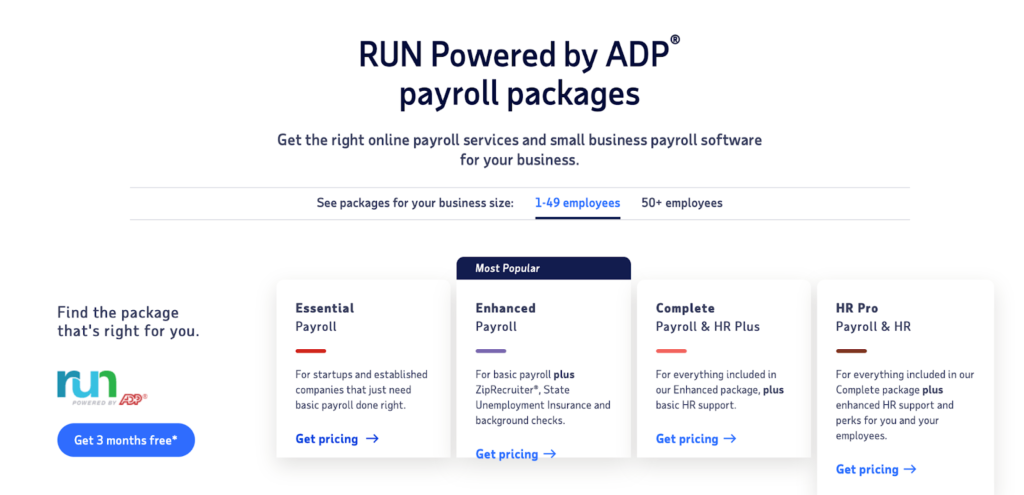
We sussed out at least basic information about RUN, so you wouldn’t have to dig through ADP’s website and give up your own contact information.
- Four levels in RUN, with more services added at each level.
- RUN Essential – $59/month plus $4 per person per month. Includes payroll processing, reporting, direct deposit
- RUN Enhanced, Run Complete, and Run HR Pro are all priced by consultation.
For companies with 50 or more employees, ADP offers ADP Workforce Now.
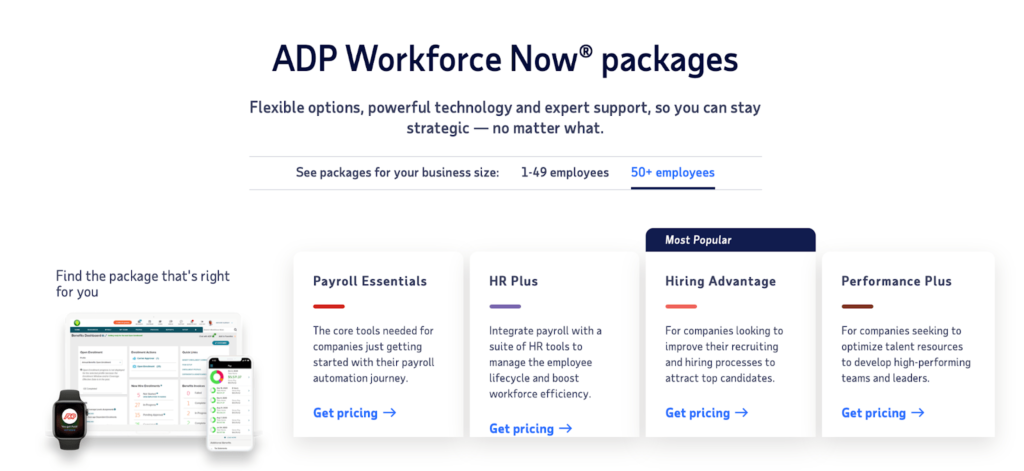
Workforce Now includes all RUN features, plus compliance reports, tailored service and custom implementation and country-based record keeping. Pricing is by consultation only.
Bottom line: ADP Payroll is a great option for companies whose dedicated and experienced payroll teams won’t want or need much hand-holding no matter how big the business grows.
How to Find the Best Online Payroll Services
Getting payroll on autopilot feels great, and that’s what the experience is like if you can find the right solution. No more stress for you or your employees–the checks just go out on time like magic.
There are a lot of factors to take into consideration when you’re evaluating your options. Below, you’ll find the methodology that I used during my research to create this guide.
Employee Self-Service
Trying to manage employee finances through an middleman is a pain. So is trying to do it all yourself, if you don’t have in-house HR support.
Enter self-service payroll.
If you choose an online payroll service that has a friendly online portal or app where employees can handle their own payroll problems, it’s going to make everyone’s’ lives easier.
Let your employees edit their own personal information like changes of address. Now if they check goes to the wrong place, employees can go in and cancel or re-order checks on their own.
It’s less responsibility for the businesss, and more freedom for employees–they can log into their account 24/7–no more waiting until Monday to resolve a critical issue.
Some services, like Gusto, help employees request PTO and see exactly how many hours they have accrued for time off.
On the other side of the coin, it also allows managers to easily take a look at, make adjustments to, and analyze employees finances and working hours. This will give you the ability to stay keyed in with your employee’s payroll and your business’s overall finances.
That’s especially important when it comes to businesses that depend on hourly employees like restaurants and retail.
Some services like Gusto and Square offer a handy mobile app for stakeholders to access their payroll information. At minimum, though, you’ll want to look for an easily accessible web portal they can access on any browser.
You can even find payroll services that offer self-onboarding for employees. Just invite them to join so they can enter personal details and bank information. Your W-2 and 1099 workers can use the self-service features to access tax documents each year, instead of you having to print and mail them on your own.
Multi-State Tax Filings
This is a pretty specific element, but one that can be incredibly important to many businesses, especially with the continuing rise of distributed teams and remote work.
After all, the global pandemic has upended the way we do work and business—perhaps permanently. Fortune 500 conglomerates and small startups alike are doing more work from home. As such, many companies are seeing an increase of workers who don’t all live in one state or region.
You need a payroll service that can help manage your employees’ payroll no matter where they are.
If your employees or contractors live in other states besides the one your company is based in, you’re going to need to register with your employee’s state tax agency and adhere to that state’s tax laws.
Some online payroll services are better for these than others. In fact, some of them might charge you an extra fee to file in multiple states.
However, OnPay gives you multi-state payroll services at no extra cost to you with all of their plans. If you have a large distributed team, I cannot recommend OnPay enough.
On the other hand, Gusto requires you to pay a little extra each month for multi-state payroll. You can’t just coast by on their cheapest plan like OnPay.
Specialized Payroll Solutions
Payroll can be as complex or as simple as the industry it serves.
For example, industries such as farms, nonprofits, food service, and contractor-reliant operations are going to require a more complex payroll system. Whereas a bootstrap startup with just three employees is going to be fairly simple.
OnPay is a good solution for most small businesses. But they also offer complex solutions for dentists, restaurant owners, or even tax-exempt organizations like nonprofits and churches.
For example, they help churches and other religious orgs exclude federal unemployment tax, Social Security tax, Medicare tax, and allowances for parsonage from their filings. They also ensure accurate filings for federal unemployment tax for nonprofits.
Square Payroll is excellent for retail businesses and restaurants since one of their most popular offerings is a handy point-of-sale solution often used by those types of businesses.
In fact, their restaurant payroll service includes specific tools for front-of-house and back-of-house employee management. That’s very handy, especially when we consider that taxes differ wildly for restaurant workers from state to state.
Pay Cycle Frequency
How often do you want to run payroll?
A lot of online payroll systems won’t restrict you to just once per week or twice per month. There are plenty of options out there that offer unlimited payroll each month like OnPay and Gusto.
This is great for those of you who don’t want to be tied into a specific schedule. In some instances, you can even let your employees decide when and how they get paid.
Maybe you want employees on salary to get paid automatically each week. But you want to manually pay independent contractors for specific amounts only once per month. There are online payroll services that let you do both with ease.
This is beneficial for companies that leverage both W9 and 1099 employees (as many orgs are want to do nowadays). This flexibility will be a boon to your company’s overall health and finances.
All-in-One Benefits
Not every payroll system has built-in options for you to set up and manage employee benefits. I’m referring to things like:
- Workers’ compensation
- 401k plans
- HSAs
- Health insurance
- Vision and dental
So if you’re offering these types of benefits to your employees, you need to find a payroll system that’s accommodating.
It’s a lot easier to manage benefits and payroll if they’re centralized on one system and portal. You don’t want to have to send your employees to a bunch of different websites to access each of their payment and benefits information. It’s annoying, and can result in a lot of confusion down the line.
Gusto and ADP Payroll are standouts in this regard. They offer an easy solution for your HR and payroll needs. ADP even partners with a ton of different benefits solutions, so you can treat your employees to things like discounts to gyms, wellness rewards, and even financial savings programs.
That can go a long way to helping both retain your talent and recruit.
Square Payroll, on the other hand, offers fairly limited employee benefits solutions (just health insurance, workers’ comp, and 401k).
Conclusion
Every business needs a payroll solution. But not every online payroll service is made to tackle the same problems. Just as your needs are unique, there are payroll services that are going to be a better fit for your business than others.
What’s the best online payroll service? The answer is different for each business owner. Here’s a quick recap of the best choices based on my methodology:
- OnPay — The best for remote workforces
- Gusto — The best if you have a ping-pong table in the break room
- Paychex — The best for complex payroll cycles
- ADP Payroll — The best for businesses making a hiring push
- Deluxe Payroll — The best price for included HR features
- QuickBooks Payroll — The best for a worry-free tax season
- Square Payroll — The best for retailers and restaurants
Whatever your unique payroll needs, there is definitely a solution for you in this guide.
from Quick Sprout https://ift.tt/2sOeAm8
via IFTTT
